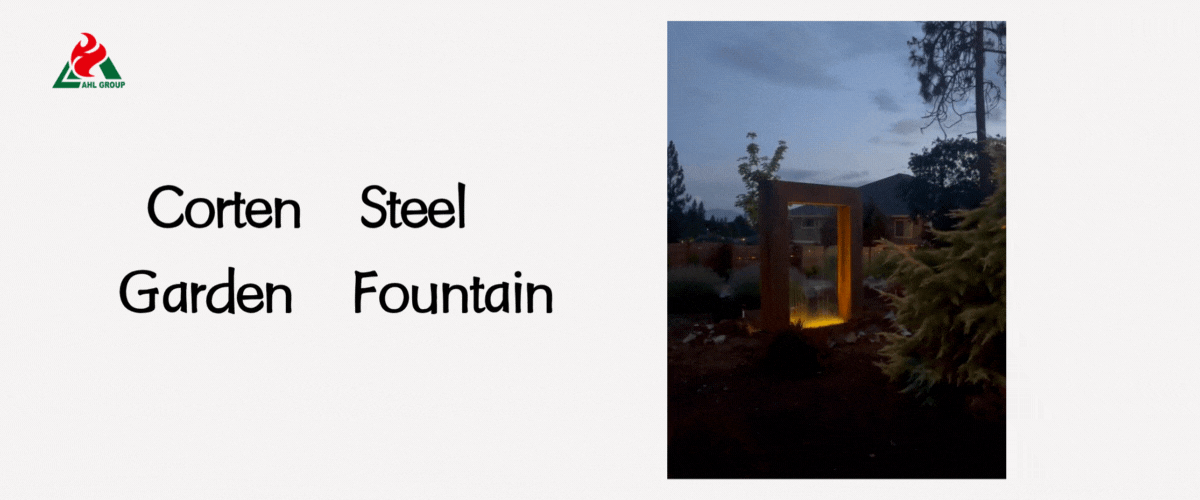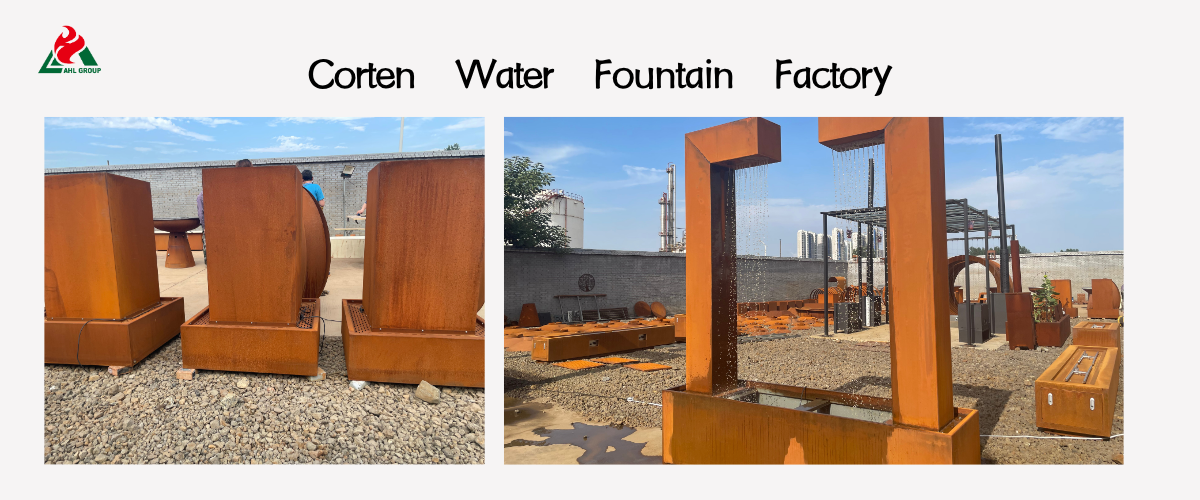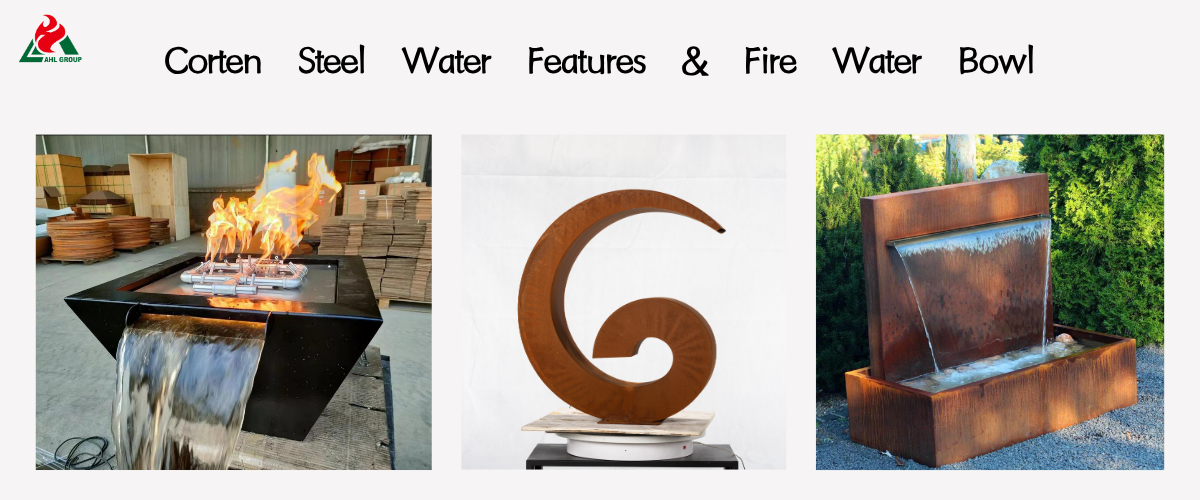Corten steel water features are designed for durability, requiring minimal maintenance while lasting for decades. Their aesthetic appeal stems from a stable protective rust layer (patina) that effectively isolates the underlying metal substrate. However, like all metal containers holding circulating water, occasional leaks may occur. The key lies in swiftly locating the leak source and implementing the correct, lasting repair solution.
To effectively repair leaks in weathering steel structures, the first step is to clearly identify the location and cause of the leak. This comprehensive guide from AHL Group provides practical solutions for common leak points—from leaking welds to localized corrosion—helping you restore the structural integrity and aesthetic appeal of your metal water feature.

To effectively repair leaks in weathering steel structures, the first step is to clearly identify the location and cause of the leak. This comprehensive guide from AHL Group provides practical solutions for common leak points—from leaking welds to localized corrosion—helping you restore the structural integrity and aesthetic appeal of your metal water feature.

Understanding Why Corten Water Features Leak
Despite the exceptional corrosion resistance of weathering steel, external factors, improper fabrication, or poor water quality can still compromise the integrity of the container.
Common Causes of Leaks in Metal Water Feature
Leakage issues typically fall into two categories: mechanical failures and material defects.
► Mechanical Failures: Include gasket failure, loose fittings, or cracked pipe joints where pumps/nozzles connect to steel.
► Structural Failures: Refer to damage to the steel itself, typically manifesting as weld failure or, in rare cases, material pitting corrosion.
Unique Challenges with Weathering Steel
While weathering steel's self-protecting properties make true material failure uncommon, issues may still arise when material integrity is compromised:
► Weld integrity: Improper welding techniques (e.g., uneven temperatures, incomplete penetration) may cause microscopic leakage cracks to develop in welds over time.
► Water chemistry: In highly corrosive aquatic environments (e.g., excessively acidic water or water with high chlorine/salt content), the protective rust layer may deteriorate or degrade, leading to localized thinning and surface pitting corrosion.

Leak Diagnosis and Troubleshooting
Locating the leak source is half the battle. Before assuming the steel itself is faulty, always inspect external connections first.
Common Leak Location 1: Seams and Welds
Welds are the weakest points in any metal structure.
Identifying and Addressing Weld Defects
► Drain and Dry: Completely drain the water and allow surfaces to dry for 24 hours.
► Visual Inspection: Examine the weld path for fine dark lines or hairline cracks. Persistent damp patches on the exterior or dark, unstable rust streaks along the seam are clear indicators of weld leakage.
► Chalk Test: Sprinkle chalk dust or flour onto the dry exterior seam. After refilling the water tank, observe where the chalk dust immediately turns black—this marks the leak point.
Common Leak Locations 2: Penetration Points and Fittings
Any location where pipes, drains, or fittings penetrate weathering steel may become a potential failure point due to gaskets and threaded connections.
Sealing Treatment for Pump Connections and Drains
► Inspect Gaskets: Check rubber gaskets or O-rings at bulkheads and connection points. Replace immediately if they show signs of brittleness, cracking, or flattening.
► Tighten Fittings: Ensure all threaded fittings are securely tightened. For pipe threads, verify installation used high-quality thread seal tape (PTFE) or pipe sealant (non-silicone).
► Use Specialized Sealants: For exposed seals where water contacts steel, use only sealants labeled marine-grade or suitable for submerged metal applications.
Common Leak Location 3: Surface Pitting and Corrosion
Such leaks are rare in high-quality weathering steel and typically occur only in highly corrosive environments.
Addressing Micro-Pore Leaks in Metal Surfaces
If leaks originate neither at joints nor fittings, they may result from micro-pits formed by prolonged localized corrosion.
► Locating: Mark leak points (often visible as fine water streams when the tank is full, or as dark spots when dry).
► Preparation: Vigorously clean the area with a wire brush to remove loose rust layers until bare metal is exposed, revealing the pits.
► Repair: Treat pinholes with metal repair compounds, such as steel powder-filled epoxy resin or specialized weathering steel sealants, ensuring the material maintains continuous water resistance.

Repair Solutions for Different Leak Types
Repair methods must match the severity and location of the failure.
Small Leak Solutions: Sealants and Epoxy Resins
Suitable for minor seepage welds or small surface pits.
► Recommended Products: Select flexible marine-grade polyurethane or silane-modified polymer (SMP) sealants. For fine pinholes, two-component steel-filled epoxy repair kits provide superior rigid patches.
► Application Tip: Sealants and epoxy must be applied internally to water fountains to avoid compromising external patina aesthetics.
Moderate Leak Solutions: Repair and Reinforcement
Suitable for longer weld failures or damaged areas requiring structural support.
► Steel Plate Repair: Cut thin sheets of weathering steel to cover internal leak areas, bonding them with strong adhesives (e.g., industrial-grade construction adhesives or heavy-duty epoxy). This method often serves as a temporary solution before professional welding.
Major Leak Solutions: Professional Welding
Applicable to structural cracks, severely damaged welds, or components with poor initial weld quality.
► AHL Recommendation: Significant structural damage requires handling by experienced welders. Welders must use electrodes compatible with weathering steel (e.g., conforming to ASTM A242 or A588 standards) to ensure the repaired area develops a protective rust layer matching the original material. Using ordinary carbon steel electrodes will create a brittle weld prone to erosion, leading to severe corrosion.
Preventing Future Leaks
Proactive maintenance minimizes the risk of leaks and ensures the long-term durability of AHL Group Corten water features.
Regular Maintenance and Inspection Schedule
Inspect all fittings, gaskets, and seams twice yearly (during spring startup and fall shutdown).
► Frequently check water levels; abnormal drops indicate leaks.
► Maintain proper water chemistry balance. Avoid excessive chlorine or strong acidic chemicals to prevent damage to patina.
Proper Freeze Protection Measures
Water freezing is the primary cause of facility damage in cold climates.
► Complete Drainage: Ensure the facility is fully drained before the first severe cold snap, including all pumps, pipes, and reservoirs.
► Remove Drain Plugs: Disengage drain plugs to allow water to drain out, preventing ice expansion damage.
Quality Installation Best Practices
Ensure initial installation meets quality standards.
► Level Foundation: Install landscape water fountains on a level, stable foundation to avoid stress on welded joints.
► Professional Piping Connections: Use flexible hoses/pipes for connections to minimize stress on rigid metal fittings during pump vibration or temperature fluctuations.

Frequently Asked Questions About Corten Water Fountain
Q: Can I Use Common Silicone Sealant on Weathering Steel?
No. Standard residential silicone sealants are typically acidic (acetic cure) and will corrode the steel beneath the weathering layer over time. Additionally, they have poor adhesion to rusted surfaces. Always use neutral-cure or high-performance marine-grade polymer sealants.
Q: How Often Should Leaks Be Inspected?
Structural issues require visual joint inspections during biannual maintenance periods (spring and fall). Pipe joints and penetrations should be checked weekly for drips during the first month of operation, then monthly thereafter.
Conclusion: Enrich Your Outdoor Space with Corten Steel Water Features
Corten metal water features represent a long-term investment, meticulously designed by AHL Group to deliver exceptional aesthetics and enduring structural integrity. By addressing common trouble spots—primarily welds and fittings—and employing appropriate repair techniques (ranging from high-performance epoxy to specialized weathering steel welding methods), you can easily resolve leakage issues. Through proactive maintenance—especially meticulous freeze protection and sensible water quality management—your weathering steel landscape will remain a focal point in your garden for decades.


